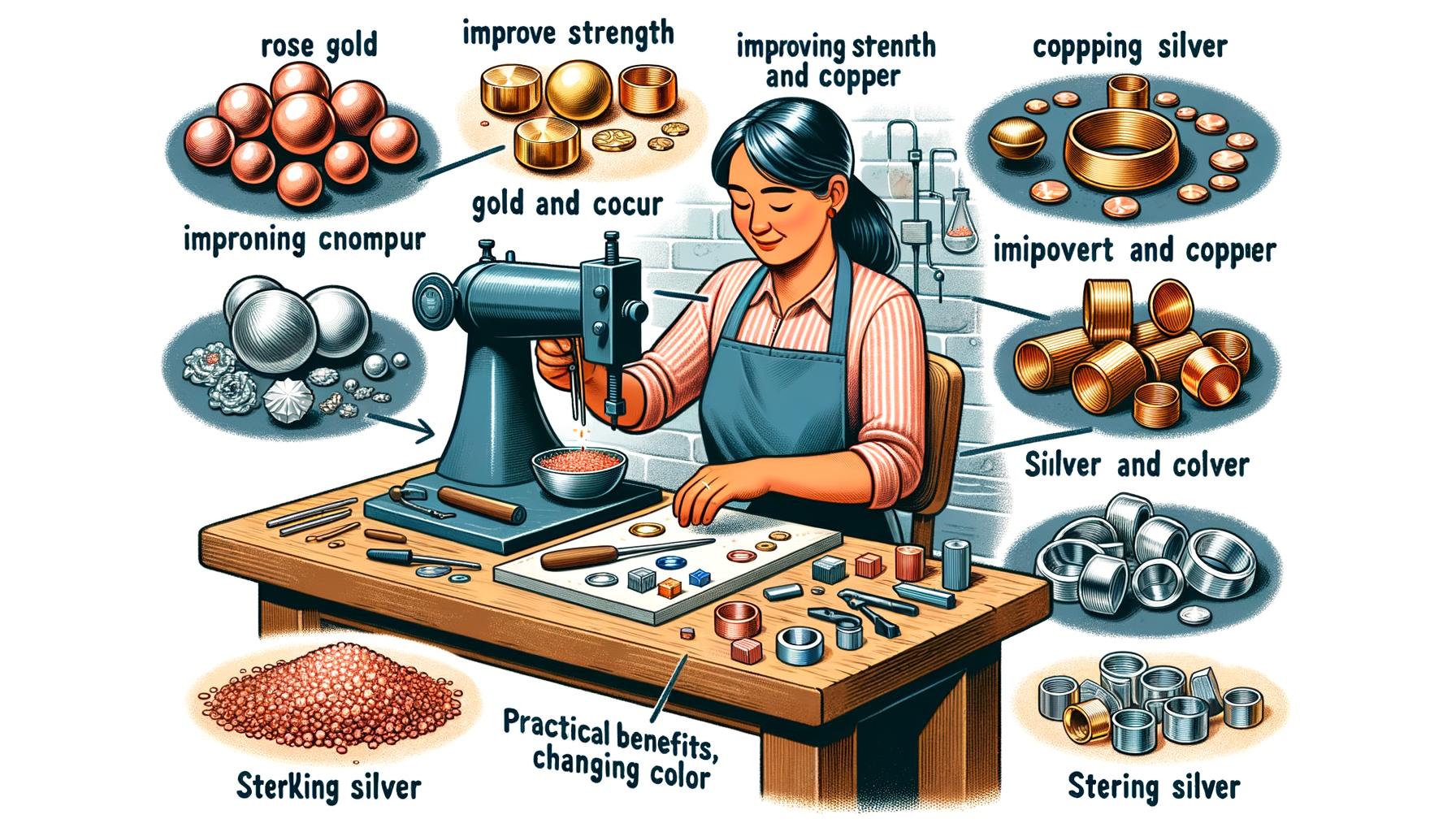The role of alloys in jewelry making: what you should know is a fascinating subject that goes beyond the allure of glistening metals and elegant designs. Alloys, which are combinations of two or more metals, play a crucial role in the jewelry industry, offering both aesthetic and functional benefits to jewelers and consumers alike.
By understanding how these metal mixtures work, one gains deeper insights into why certain pieces of jewelry stand out not only in beauty but also in durability and versatility.
Pure metals like gold, silver, and platinum may capture the imagination with their natural luster and appeal; however, they often lack certain physical properties required for practical wear. Pure gold, for instance, is too soft to withstand daily use without easily getting scratched or deformed. This is where alloys come into play. By combining pure metals with other elements such as copper, nickel, or palladium, jewelers can enhance the strength and resilience of their creations without compromising on beauty.
Historically speaking, the use of alloys in jewelry-making dates back thousands of years. Ancient civilizations like the Egyptians and Romans were already adept at blending different metals to create stunning ornaments that could endure through time.
Fast forward to today’s modern age, and you’ll find that alloy technology has become increasingly sophisticated-enabling jewelers to explore new possibilities while maintaining ethical sourcing practices. Whether you’re a jewelry enthusiast or an aspiring jeweler, understanding the significance of alloys will undoubtedly elevate your appreciation for these timeless treasures.
History of Alloys in Jewelry
Ancient Civilizations and the Birth of Alloy Use
The use of alloys in jewelry making dates back to ancient civilizations, who discovered early on that blending metals could significantly improve the properties of their adornments. This discovery marked a revolutionary step in crafting techniques, transforming how societies viewed and utilized metals.
Egyptians are often credited with pioneering the practice around 3000 BC, using combinations like gold mixed with silver (known as electrum) to create resilient and beautiful pieces that adorned both royalty and deities. Similarly, Mesopotamian craftsmen used copper mixed with tin to produce bronze, creating exquisite rings, bracelets, and ornaments that were more durable than pure copper.
Advancements Through Metallurgical Innovations
As civilizations progressed, so did their metallurgical understanding. During the Bronze Age (3300-1200 BC), there was a significant leap in alloy-based jewel crafting due to improved smelting techniques. The Greeks further advanced these practices by perfecting methods to enhance not only the aesthetic appeal but also the functional aspects of jewelry pieces.
For instance, they developed innovative quenching processes that contributed to increased hardness and durability in alloys used for intricate designs. It is here that we see a sophisticated appreciation for what different metal combinations could offer-a foundational concept for modern jewelers exploring the role of alloys in jewelry making: what you should know.
The Renaissance Influence on Alloy Diversity
The Renaissance period brought about an explosion of artistic expression which extended into jewelry making through advanced alloys. Italian craftsmen became renowned for their ability to blend metals like gold and copper to achieve unique hues that captured light differently than simple blends available before.
This era’s experimentation laid groundwork for today’s vast palette of alloy compositions used by jewelers worldwide. The refinement processes developed during this time enabled finer control over color outcomes and structural integrity-attributes highly prized by contemporary artisans who continuously seek new ways to combine traditional techniques with cutting-edge material science.
What Is an Alloy? Understanding the Basics
When exploring the world of jewelry, it’s essential to understand what alloys are and their significance. In simple terms, an alloy is a metal made by combining two or more metallic elements to enhance its properties. This process of mixing metals isn’t merely for aesthetic purposes; it serves practical roles as well.
For instance, pure gold, while beautiful, is incredibly soft and impractical for everyday wear. The introduction of other metals such as silver or copper into gold forms an alloy that retains gold’s desirable appearance but gains strength and durability.
Creating an alloy involves selecting appropriate base metals and combining them under specific conditions to achieve the desired characteristics. This might include adjusting temperature settings and using various advanced techniques in metallurgy to control the outcome precisely.
Having a basic grasp of this process can help you appreciate why certain pieces of jewelry stand out in terms of quality and longevity. Through careful selection and manipulation of components, jewelers create pieces that are not only visually stunning but also practical for daily wear.
It’s fascinating how different combinations can lead to unique results in jewelry making. For example, white gold is created by blending yellow gold with metals like palladium or nickel to produce a silvery-white hue similar to platinum but generally at a lower cost.
Rose gold, on the other hand, achieves its distinct pinkish color through an alloying process that includes copper. By understanding this fundamental concept – the role of alloys in jewelry making: what you should know – you embark on a journey appreciating both the craftsmanship involved and the science underpinning these timeless adornments.
The Science Behind Alloy Creation
Metallurgy is the field dedicated to studying metals’ physical and chemical behaviors, including their interactions when forming alloys. The goal is often to improve upon pure metal’s natural properties such as tensile strength, hardness, ductility, corrosion resistance, and aesthetics. When creating an alloy, scientists consider factors like melting points and solubility limits – how well one metal dissolves into another under heat.
This intricate balance can drastically impact the resulting material’s performance in various applications beyond just aesthetics-whether it’s for aerospace use requiring lightweight yet durable materials or crafting beautiful yet robust jewelry pieces meant for everyday wear. By tweaking these variables through precise methods developed over centuries, modern metallurgy continually evolves our ability to produce superior-quality alloys tailored explicitly towards high standards set by today’s jewelers.
Practical Outcomes From Different Alloy Combinations
The type of base metals blended together determines an alloy’s final attributes significantly affecting your finished jewelry products’ look and feel-and often even their perceived luxury level. Take sterling silver (<92% pure silver mixed mainly with around 7% copper), which produces highly lustrous yet affordable items; compared against fine karat-rated European hallmark stamped versions delivering premium feelings practically radiate opulence true hallmark symbol bridged eras evoking timeless elegance recognition worldwide.Similarly insightful comparisons unfold among platinum-gold blends fostering evolving hybrid iterations revolutionary 'paltinandium' birthing cutting-edge creations poised invite adoring aficionados global stage ready revolutionize - balancing affordability accessibility concurrently redefine heirloom traditions anew sparking consumer intrigue alike veritable legacy et sterling standing testament ingenuity captivating spirit allure commanding profound respect admiration indeed.
Common Alloys Used in Jewelry Making
Gold, silver, and platinum alloys are some of the most commonly used materials in jewelry making due to their unique properties and aesthetic appeal. Each of these metals is often combined with other elements to enhance durability, workability, and appearance.
For example, gold is frequently alloyed with metals such as copper, nickel, or zinc to create variations like white gold and rose gold. White gold usually contains a mixture of gold and palladium or nickel which gives it a silvery hue, whereas rose gold comprises gold and copper for a pinkish tint.
Sterling silver is another popular choice among jewelers. Pure silver is too soft for most practical uses; hence it is typically alloyed with other metals like copper to increase its strength while maintaining its luster. Sterling silver specifically refers to an alloy containing 92.5% pure silver and 7.5% other metals, predominantly copper. This combination aids in preventing tarnish-a common issue with pure silver-making sterling silver jewelry more durable for everyday wear.
Platinum alloys also hold a significant position in the realm of high-end jewelry due to their rarity and durable nature. Jewelers often mix platinum with elements such as ruthenium or cobalt to improve hardness and resistance to scratching without compromising its inherent gleaming white beauty. Typically, platinum jewelry must consist of at least 85% pure platinum; this ensures that pieces retain the precious metal’s prestigious status while benefiting from enhanced robustness provided by the additional elements.
These common alloys provide many benefits that make them indispensable in the manufacture of fine jewelry. Understanding the role of alloys in jewelry making: what you should know, can immensely benefit both jewelers looking to craft outstanding pieces and consumers aiming for quality investments in their adornments.
- Gold Alloys: White Gold (gold + palladium/nickel), Rose Gold (gold + copper)
- Silver Alloys: Sterling Silver (92.5% silver + 7.5% copper)
- Platinum Alloys: Platinum + Ruthenium/Cobalt (minimum 85% pure platinum)
This integration of various metals creates materials specifically tailored for different needs within the jewelry industry-from enhancing aesthetic qualities like color variations to bolstering practical applications such as scratch resistance and structural integrity.
Benefits of Using Alloys in Jewelry
One of the primary benefits of using alloys in jewelry is their enhanced durability. Pure metals, like 24-karat gold or fine silver, are typically quite soft and susceptible to scratching or deforming from everyday wear. When alloyed with other metals, however, they become more robust and resilient.
For instance, adding copper to gold not only strengthens the metal but also retains its aesthetic qualities. This enhancement means that your cherished pieces will stand the test of time better than their pure metal counterparts.
Another significant advantage is malleability. While certain pure metals may be too rigid or brittle to work with easily, alloying them with other materials often makes them more pliable.
This increased ductility allows jewelers to craft intricate designs and delicate details that would otherwise be challenging or impossible to achieve with pure metals alone. The role of alloys in jewelry making: what you should know is that integrating substances like nickel or zinc can vastly improve flexibility without sacrificing the integrity of the final product.
Cost-effectiveness is also a noteworthy benefit related to alloys in jewelry making. Pure precious metals can be prohibitively expensive for both jewelers and consumers. By using alloys, jewelers can offer beautiful designs at a variety of price points without compromising on quality or craftsmanship.
Additionally, alloys can enhance other properties such as luster and resistance to tarnish, ensuring that both affordable and high-end pieces maintain their shine and visual appeal over time. This makes alloyed pieces smarter investments for those looking to buy lasting jewelry within their budget constraints.
How Alloys Affect the Properties of Finished Jewelry
The choice of alloys significantly influences the final properties of jewelry, making it an area both artisans and consumers need to understand. The introduction of different metals into a base metal like gold, silver, or platinum alters not only its appearance but also its physical characteristics.
For instance, adding copper to gold results in rose gold which has a warm hue and increased hardness compared to pure gold. This adaptability allows jewelers to customize the aesthetic and functional qualities of their pieces.
Alloy combinations vary based on desired outcomes. Sterling silver, for example, is an alloy composed of 92.5% silver and 7.5% other metals such as copper.
This mixture enhances the durability and strength of the resulting jewelry while maintaining most of the visual properties of pure silver. Similarly, white gold is produced by blending yellow gold with white metals like palladium or nickel which gives it a more neutral color often coated with rhodium for extra brightness and protection from tarnish.
Furthermore, non-traditional alloys are making their way into modern jewelry design due to advanced metallurgical research. Combinations like titanium alloys offer extreme lightness paired with high strength, making them suitable for those in search of robust yet elegant pieces. Knowing about such innovations helps consumers make informed choices regarding the look and longevity they desire from their jewelry collections.
| Base Metal | Common Additives | Resulting Properties |
|---|---|---|
| Gold | Copper (Rose Gold), Silver & Palladium (White Gold) | Variety in color (Rose/White) and enhanced hardness |
| Silver | Copper (Sterling Silver) | Increased durability while keeping a bright luster |
| Titanium | Aluminum & Vanadium | Extreme lightness combined with superior strength |
Understanding the role of alloys in jewelry making: what you should know is essential for appreciating how these materials affect both the artistry and functionality of fine ornaments. By manipulating alloy compositions, jewelers can offer diverse products that meet various needs ranging from aesthetic preferences to practical wearability requirements.
Alloys and Hypoallergenicity
When choosing jewelry, especially for those with sensitive skin, understanding the role of alloys in jewelry making: what you should know about hypoallergenic properties is crucial. Certain metals commonly used in creating alloys can cause allergic reactions, leading to discomfort or even severe skin issues. Nickel, for instance, is known to be a common allergen and is often avoided in hypoallergenic jewelry.
For individuals with sensitive skin, it’s important to look for alloys that are known for their hypoallergenic properties. These include:
– Titanium Alloys: Titanium is biocompatible and widely used in medical implants due to its non-reactive nature. Jewelry made with titanium alloys does not cause adverse reactions.
– Niobium: Another excellent choice for hypoallergenic jewelry, niobium doesn’t contain alloying elements that could lead to sensitivity issues.
– Gold Alloys: While pure gold (24 karats) is generally safe for those with allergies, it’s too soft for practical use. Alloys like 18-karat or higher predominantly contain gold mixed with inert metals that minimize allergic reactions.
Moreover, sterling silver is often touted as a good option because it usually comprises 92.5% pure silver and 7.5% copper-metals less likely to provoke an allergic reaction compared to nickel. However, one should still verify if any traces of other metals are included before purchasing.
If you’re looking to avoid allergens completely, consider the following tips when shopping for alloy jewelry:
1. Check Labels: Always look at the composition details on the jewelry tag.
2. Ask Questions: Don’t hesitate to ask the jeweler about the specific metals used in their pieces.
3. Purity Marks: Pay attention to hallmarks indicating purity standards which can help you identify potential allergens.
Incorporating non-allergenic materials into your collection not only helps avoid discomfort but also broadens your understanding of how different alloys affect both aesthetic and wearability aspects of fine jewelry pieces.
Industry Standards and Purity Marks in Alloys
The jewelry industry employs various standards and purity marks to ensure that consumers can identify and authenticate the quality of their purchases. These marks represent not just the metal content but also guarantee that buyers receive the sophistication and durability they expect from fine jewelry. In gold jewelry, for instance, purity is measured in karats.
24-karat gold is 100% pure gold, while 18-karat gold consists of 75% gold and 25% other metals like copper or silver. This standardization allows jewelers to create pieces that maintain an optimal balance between beauty and practicality.
Global standards for measuring purity extend beyond just labeling; they are ingrained in hallmarking practices which vary by region but serve a similar purpose worldwide. In many countries, such as the United Kingdom, the hallmark will include several marks: a maker’s mark, a standard mark indicating metal fineness (e.g.
“925” for sterling silver), an assay office mark certifying testing, and sometimes even a date letter indicating the year of marking. Similar approaches are found across Europe and North America, ensuring transparency in the reporting of metal contents used in alloys.
| Region | Type of Mark | Description |
|---|---|---|
| United States | Karat System | Markings like “14K” indicate the gold purity level. |
| United Kingdom | Hallmarking System | A combination of symbols including a maker’s mark and standard mark. |
Not only do these markings offer peace of mind regarding authenticity and value, but they also play a crucial role in sustaining customer trust within the industry. The role of alloys in jewelry making: what you should know cannot be fully comprehended without recognizing how essential transparency through proper marking systems is to both jewelers and customers.
How to Care for Alloy Jewelry
Caring for alloy jewelry is essential to preserving its beauty and longevity. One of the first things to consider is proper cleaning techniques. It is recommended to clean your alloy jewelry regularly with a soft cloth and mild soap solution. Avoid harsh chemicals that can damage the metal’s surface. For intricate pieces, use a soft-bristle brush to gently remove any dirt or grime, ensuring every crevice is spotless.
Storage practices also play a critical role in maintaining the condition of alloy jewelry. Always store your pieces in a dry, cool place, preferably in individual pouches or compartments to prevent scratching and tarnishing. Humidity can accelerate tarnish rates, so silica gel packs or anti-tarnish strips can be beneficial when placed alongside your jewelry.
Professional upkeep services are another excellent way to prolong the life of your treasured items. Jewelers offer various maintenance options, including polishing, re-plating, and inspection for structural integrity which can help repair components like clasps and settings before they become major issues. Understanding the role of alloys in jewelry making: what you should know enhances your ability to care for these precious items properly by appreciating their material characteristics and needs.
Common care tips include:
- Regularly inspecting for signs of wear.
- Avoiding exposure to chemicals such as chlorine.
- Taking off jewelry when performing activities that could lead to physical damage.
By following these guidelines, you ensure that your alloy jewelry remains stunning and durable for years to come.
Ethical and Sustainable Alloy Sourcing
Ethically and sustainably sourcing materials for alloys in jewelry making is becoming increasingly important as consumers become more aware of the environmental and social impact of their purchases. The role of alloys in jewelry making: what you should know extends beyond just the craftsmanship-it encompasses responsible sourcing that ensures minimal harm to communities and ecosystems.
Ethical sourcing means acquiring metals from mines and suppliers that adhere to fair labor practices, provide proper wages, ensure safe working conditions, and respect local communities.
Many jewelers are turning to recycled metals as a sustainable alternative. Recycled gold, silver, and platinum dramatically reduce the environmental footprint by lowering the need for mining new resources. This method not only limits ecological disruption but also conserves natural habitats affected by large-scale extractions. Several certified programs like the Responsible Jewellery Council (RJC) and Fairtrade Gold enforce stringent guidelines on ethical mining practices-ensuring ores are obtained under humane conditions while promoting transparency throughout the supply chain.
Environmental sustainability also includes reducing carbon footprints through efficient alloy production techniques. Jewelers can contribute by adopting green manufacturing processes that use renewable energy sources or advanced recycling technologies to minimize waste. Furthermore, ethical alloy sourcing involves rigorous auditing of suppliers to ensure compliance with global standards such as OEKO-TEX® certifications which emphasize non-toxic materials free from harmful chemicals.
| Aspect | Description |
|---|---|
| Recycled Metals | Limits environmental impact by reducing the need for new mining operations. |
| Certified Programs | Programs like RJC and Fairtrade Gold ensure metal sourcing follows ethical practices. |
| Sustainable Manufacturing | Utilizes green techniques to reduce waste and carbon emissions. |
By choosing ethically sourced alloys, jewelers can positively influence both the environment and society, meeting consumer demands for sustainable luxury.
Future Trends in Alloys and Jewelry Making
The world of jewelry making continues to evolve, driven by advancements in technology and shifts in consumer preferences. One emerging trend is the development of eco-friendly alloys. As awareness of environmental sustainability grows, jewelers are increasingly focusing on creating high-quality pieces while minimizing their ecological footprints.
This involves the use of recycled metals, reducing waste, and sourcing materials responsibly. The role of alloys in jewelry making: what you should know incorporates not only traditional elements but also these new sustainable practices.
Innovative materials are also making headway in the jewelry industry. For instance, alternative metals such as titanium and tungsten are becoming more popular due to their unique properties and aesthetic appeal. These metals offer incredible durability and scratch resistance compared to traditional options like gold or silver, appealing especially to consumers seeking long-lasting everyday wear items. Experimental combinations of metals within alloys can result in striking new color variations and textures, opening up creative possibilities for contemporary designers.
Furthermore, the integration of modern technology like 3D printing is revolutionizing how alloy jewelry is produced. This advanced manufacturing technique allows precise control over design and composition, enabling intricate details that were previously difficult or impossible to achieve with traditional methods. It also speeds up prototyping processes, allowing faster innovation cycles within the industry. As these technologies continue to advance, we can expect even more exciting breakthroughs in alloy compositions and applications in the near future.
Conclusion
As we’ve journeyed through the intricate world of alloys in jewelry making, it becomes unmistakably clear that these carefully formulated mixtures of metals hold a pivotal role in crafting beautiful, durable, and versatile pieces. From ancient civilizations to modern-day artisans, the use of alloys has continually evolved, bringing with it advancements that offer both aesthetic appeal and the necessary durability to withstand everyday wear.
Understanding the role of alloys in jewelry making: what you should know is essential for both creators and consumers who seek quality and longevity in their adornments.
One significant aspect is how alloys fundamentally transform base metals into shining treasures adorned by many. The unique combinations of various metals create specific properties like enhanced strength, resistance to tarnish, and improved malleability which are vital for detailed craftsmanship. Jewels crafted from gold, silver, or platinum alloys not only possess stunning luster but also maintain functionality over extended periods. Moreover, knowing about hypoallergenic options helps individuals with sensitivities make informed choices about their jewelry purchases.
Looking forward, the industry shows promise with ongoing innovations directed towards sustainability and ethical sourcing. Ensuring that metals used in alloy production come from responsibly managed sources addresses not only environmental concerns but also fair labor practices. This conscientious approach benefits all stakeholders involved-from miners to end-users-while paving the way for new material discoveries and technological advancements in alloy manufacturing processes.
In essence, grasping the complexities behind the role of alloys provides comprehensive insights into their indispensable contribution to jewelry making. As trends continue to change and technology advances further refine these metal mixtures, both jewelers and consumers stand to gain from a deeper understanding of this crucial element within the age-old craft of creating timeless treasures.
Frequently Asked Questions
Why Are Alloys Important in Jewelry Making?
Alloys play a crucial role in jewelry making due to their enhanced properties, such as increased strength, durability, and resistance to tarnish compared to pure metals. Pure gold or silver, for instance, is usually too soft for crafting durable pieces of jewelry that can withstand everyday wear.
By mixing these metals with other elements like copper or nickel, jewelers can create alloys that retain the desirable aesthetics of the precious metals while significantly improving their functional characteristics.
Which Alloy Is Used for Making Jewellery?
One commonly used alloy in jewelry making is sterling silver, which consists of 92.5% pure silver and 7.5% other metals, typically copper. This blend retains the shiny luster of pure silver while providing the hardness necessary for crafting intricate and durable jewelry pieces.
Another popular alloy is 18-karat gold which comprises 75% gold and 25% other metals like copper or silver; this combination balances the rich color of gold with sufficient hardness for practical use in rings, necklaces, and bracelets.
What Is Alloy in Jewellery?
In the context of jewelry, an alloy refers to a mixture of two or more elements where at least one component is a metal used to enhance specific properties desired in the finished product. For example, combining gold with small amounts of nickel or zinc creates an alloy that remains aesthetically pleasing yet offers considerably better mechanical strength than pure gold.
This makes alloys indispensable in achieving the fine balance between aesthetic appeal and functional robustness necessary for high-quality jewelry items that are both beautiful and long-lasting.

Welcome to my jewelry blog! My name is Sarah and I am the owner of this blog.
I love making jewelry and sharing my creations with others.
So whether you’re someone who loves wearing jewelry yourself or simply enjoys learning about it, be sure to check out my blog for insightful posts on everything related to this exciting topic!





